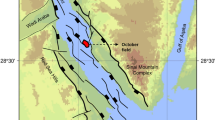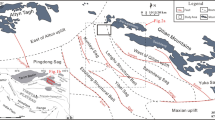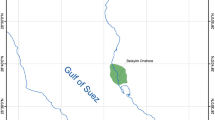Abstract
An integrated petrological and geochemical analysis of surface and drilled oil sands from the Middle Jurassic Yan’an Formation in the southern Ordos Basin was conducted to investigate the petrophysical properties, organic matter origin/type, and thermal maturity and their relation to environmental conditions during sediment deposition. Petrographic analysis (thin section, scanning electron microscopy (SEM), and porosity and permeability determination) of the oil sand was performed to establish the relationships between porosity and permeability and bulk density, reservoir quality index (RQI), normalized porosity index (NPI), and flow zone indicator (FZI). Geochemical analyses include oil extraction, column chromatography, and gas chromatography–mass spectrometry (GC-MS). The strong correlation between RQI and permeability (R2 = 0.98) reveals that porosity has a good correlation with RQI. The positive correlations between porosity and permeability and NPI and RQI (R2 = 0.77 and R2 = 0.65, respectively) show that the studied rocks contain many large pores with pore-to-pore throat connection structures that enhance permeability, which is further supported by the relatively high connection coefficient between NPI and RQI (R2 = 0.65). The organic matter in the Yan’an Formation is mainly composed of oil-prone type I kerogen indicated by the recovery of a large amount of crude oil rich in saturated hydrocarbon fractions from the extracted oil. The biomarker signatures of the analyzed oil (nC13-nC35, Pr/n-C17 and Ph/n-C18, and low C27/C29 regular sterane) reveal predominantly land plant materials as organic input sources based on the average concentration of αααC27:C28:C29 sterane 20R of approximately 38%, 22%, and 40%, respectively, and on high values of tricyclic terpane/αβC30 hopane and regular sterane/αβC30 hopane. Deposition within a lacustrine paleoenvironment under anoxic conditions enhanced organic matter preservation in the area based on the low Pr/Ph ratios (average 0.74), low αβC31-22R-hopane/αβC30 hopane ratios, and high C26/C25 tricyclic terpane ratios, as well as the presence of gammacerane and low water salinity. Biomarker maturity parameters (e.g., C32 homohopane 22S/(22S + 22R), moretane/hopane, and C29 sterane 20S/(20S + 20R) ratios and CPI) show that the extracted oil sand entered the early oil window stage.


















Similar content being viewed by others
References
Al-Ajmi, F. A., & Holditch, S. A. (2000). Permeability estimation using hydraulic flow units in a Central Arabia reservoir. In SPE Annual Technical Conference and Exhibition. Society of Petroleum Engineers.
Alali N, Pishvaie MR, Jabbari H (2009) A new semi-analytical modeling of steam-assisted gravity drainage in heavy oil reservoirs. J Pet Sci Eng 69(3):261–270
Amaefule, J. O., Altunbay, M., Tiab, D., Kersey, D. G., & Keelan, D. K. (1993). Enhanced reservoir description: using core and log data to identify hydraulic (flow) units and predict permeability in uncored intervals/wells. In SPE annual technical conference and exhibition. Society of Petroleum Engineers.
Asif M, Fazeelat T, Jalees MI (2014) Biomarker and stable carbon isotopic study of Eocene sediments of North-Western Potwar Basin, Pakistan. J Pet Sci Eng 122:729–740
Atoyebi, A. O., Adekola, S. A., & Akinlua, A. (2017). Tricyclic terpane geochemistry of source rocks from Northwestern and Central Niger Delta. Petroleum Science and Technology, 1-8.
Boggs, S. (2009). Petrology of sedimentary rocks. Cambridge University Press.
Brooks PW (1986) Biological marker geochemistry of oils from the Beaufort-Mackenzie region, Arctic Canada. Bull Can Petrol Geol 34(4):490–505
Butler RM, Stephens DJ (1981) The gravity drainage of steam-heated heavy oil to parallel horizontal wells. J Can Pet Technol 20(02)
Cai C, Hu G, He H, Li J, Li J, Wu Y (2005) Geochemical characteristics and origin of natural gas and thermochemical sulphate reduction in Ordovician carbonates in the Ordos Basin, China. J Pet Sci Eng 48(3):209–226
Castorena, D. G., Espinosa, J. A., & Vázquez-Gomez, B. (2013). Asphalt global market analyst-Consumption, demand & industry forecast. In Technology Management in the IT-Driven Services (PICMET), 2013 Proceedings of PICMET'13: (pp. 2181-2187). IEEE.
Corbett, R. E., & Heng, C. K. (1971). Lichens and fungi Part IX. 17α H-hopane and 17α H-moretane and their derivatives. Journal of the Chemical Society C: Organic, 1885-1888.
Corbett, P. W. M., & Potter, D. (2004). Petrotyping: a basemap and atlas for navigating through permeability and porosity data for reservoir comparison and permeability prediction. In Paper SCA2004-30 presented at the International Symposium of the Society of Core Analysts (pp. 5-9).
Cranwell PA, Eglinton G, Robinson N (1987) Lipids of aquatic organisms as potential contributors to lacustrine sediments—II. Org Geochem 11(6):513–527
Cross TA (2000) Stratigraphic controls on reservoir attributes in continental strata. Earth Science Frontiers 7(4):322–350
Czochanska Z, Gilbert TD, Philp RP, Sheppard CM, Weston RJ, Wood TA, Woolhouse AD (1988) Geochemical application of sterane and triterpane biomarkers to a description of oils from the Taranaki Basin in New Zealand. Org Geochem 12(2):123–135
Dai J, Li J, Luo X, Zhang W, Hu G, Ma C, Guo J, Ge S (2005) Stable carbon isotope compositions and source rock geochemistry of the giant gas accumulations in the Ordos Basin, China. Org Geochem 36(12):1617–1635
Damsté JSS, Kenig F, Koopmans MP, Köster J, Schouten S, Hayes JM, de Leeuw JW (1995) Evidence for gammacerane as an indicator of water column stratification. Geochim Cosmochim Acta 59(9):1895–1900
Darby BJ, Ritts BD (2002) Mesozoic contractional deformation in the middle of the Asian tectonic collage: the intraplate Western Ordos fold–thrust belt, China. Earth Planet Sci Lett 205(1):13–24
Ding W, Zhu D, Cai J, Gong M, Chen F (2013) Analysis of the developmental characteristics and major regulating factors of fractures in marine–continental transitional shale-gas reservoirs: a case study of the Carboniferous–Permian strata in the southeastern Ordos Basin, central China. Mar Pet Geol 45:121–133
Duan Y (2012) Geochemical characteristics of crude oil in fluvial deposits from Maling oilfield of Ordos Basin, China. Org Geochem 52:35–43
Duan Y, Wang CY, Zheng CY, Wu BX, Zheng GD (2008) Geochemical study of crude oils from the Xifeng oilfield of the Ordos basin, China. J Asian Earth Sci 31(4):341–356
Ebukanson EJ, Kinghorn RRF (1986) Maturity of organic maiter in the Jurassic of southern England and its relation to the burial history of the sediments. J Pet Geol 9(3):259–280
EIA, U (2012). Annual energy review 2011. Energy Information Administration.
England PC, Richardson SW (1977) The influence of erosion upon the mineral fades of rocks from different metamorphic environments. J Geol Soc 134(2):201–213
Feng C, Yang H, Pu R, Wang Y, Wang D, Liang X, Zhang M, Huang Y, Fei S (2017) Lithology and oil-bearing properties of tight sandstone reservoirs: Chang 7 member of Upper Triassic Yanchang Formation, southwestern Ordos Basin, China. Geosci J 21(2):201–211
Füchtbauer, H., & Schmincke, H. U. (1974). Sediments and Sedimentary Rocks, 1.
Gang C (1999) Terrigenous clastic composition and its tectonic feature in the Mesozoic of the Ordos Basin [J]. Acta Sedimentol Sin 3:011
Grantham PJ (1986) Sterane isomerisation and moretane/hopane ratios in crude oils derived from Tertiary source rocks. Org Geochem 9(6):293–304
Guidish TM (1985) Basin evaluation using burial history calculations: an overview. AAPG Bull 69(1):92–104
Gurgey K (1999) Geochemical characteristics and thermal maturity of oils from the Thrace Basin (western Turkey) and western Turkmenistan. J Pet Geol 22(2):167–189
Hanson AD, Ritts BD, Moldowan JM (2007) Organic geochemistry of oil and source rock strata of the Ordos Basin, north-central China. AAPG Bull 91(9):1273–1293
Ji W, Song Y, Jiang Z, Wang X, Bai Y, Xing J (2014) Geological controls and estimation algorithms of lacustrine shale gas adsorption capacity: a case study of the Triassic strata in the southeastern Ordos Basin, China. Int J Coal Geol 134:61–73
Kara-Gülbay R, Kırmacı MZ, Korkmaz S (2012) Organic geochemistry and depositional environment of the Aptian bituminous limestone in the Kale Gümüşhane area (NE-Turkey): an example of lacustrine deposits on the platform carbonate sequence. Org Geochem 49:6–17
Kassab MA, Abdou AA, El Gendy NH, Shehata MG, Abuhagaza AA (2017) Reservoir characteristics of some Cretaceous sandstones, North Western Desert, Egypt. Egypt J Pet 26(2):391–403
Lianbo Z, Xiang-Yang L (2009) Fractures in sandstone reservoirs with ultra-low permeability: a case study of the Upper Triassic Yanchang Formation in the Ordos Basin, China. AAPG Bull 93(4):461–477
Liu S, Yang S (2000) Upper Triassic–Jurassic sequence stratigraphy and its structural controls in the western Ordos Basin, China. Basin Res 12(1):1–18
Liu C, Zhao H, Sun Y (2009) Tectonic background of Ordos Basin and its controlling role for basin evolution and energy mineral deposits. Energy Explor Exploit 27(1):15–27
Mabrey, A. N. (2016). Rock quality index for Niobrara horizontal well drilling and completion optimization, Wattenberg field, Colorado (Doctoral dissertation, Colorado School of Mines. Arthur Lakes Library).
Makeen YM, Abdullah WH, Hakimi MH, Hadad YT, Elhassan OMA, Mustapha KA (2015a) Geochemical characteristics of crude oils, their asphaltene and related organic matter source inputs from Fula oilfields in the Muglad Basin. Sudan Mar Pet Geol 67:816–882
Makeen YM, Abdullah WH, Hakimi MH, Elhassan OMA (2015b) Organic geochemical characteristics of the Lower Cretaceous Abu Gabra Formation in the Great Moga oilfield, Muglad Basin, Sudan: implications for depositional environment and oil-generation potential. J Afr Earth Sci 103:102–112
Makeen YM, Abdullah WH, Ayinla HA, Hakimi MH, Sia S (2016) Sedimentology, diagenesis and reservoir quality of the upper Abu Gabra Formation sandstones in the Fula Sub-basin, Muglad Basin. Sudan Mar Petroleum Geol 77:1227–1242
McKirdy, D. M., Kantsler, A. J., Emmett, J. K., and Aldridge, A. K. (1984). Hydrocarbon genesis and organic facies in Cambrian carbonates of the Eastern Officer Basin, South Australia. In: Petroleum geochemistry and source rock potential of carbonate rocks (J. G. Palacas, ed.) American Association of Petroleum Geologists, Studies in Geology No. 18, P. 13-31.
Meyer, R. F., Attanasi, E. D., & Freeman, P. A. (2007). Heavy oil and natural bitumen resources in geological basins of the world (No. 2007-1084).
Meyers PA (1997) Organic geochemical proxies of paleoceanographic, paleolimnologic, and paleoclimatic processes. Org Geochem 27(5):213–250
Moldowan JM, Seifert WK, Gallegos EJ (1983) Identification of an extended series of tricyclic terpanes in petroleum. Geochim Cosmochim Acta 47(8):1531–1534
Moldowan JM, Seifert WK, Gallegos EJ (1985) Relationship between petroleum composition and depositional environment of petroleum source rocks. AAPG Bull 69(8):1255–1268
Peters, K. E., & Moldowan, J. M. (1993). The biomarker guide: interpreting molecular fossils in petroleum and ancient sediments.
Peters, K. E., Walters, C. C., & Moldowan, J. M. (2005). The biomarker guide (Vol. 1). Cambridge University Press.
Pettijohn, F. J., Paul, E. P., Raymond, S. (1972). Petrographic classification and glossary. Sand and Sandstone. 149-174.
Porras, J. C., Barbato, R., & Khazen, L. (1999, January). Reservoir flow units: a comparison between three different models in the Santa Barbara and Pirital fields, North Monagas area, Eastern Venezuela Basin. In Latin American and Caribbean Petroleum Engineering Conference. Society of Petroleum Engineers.
Ren Z, Zhang S, Gao S, Cui J, Xiao Y, Xiao H (2007) Tectonic thermal history and its significance on the formation of oil and gas accumulation and mineral deposit in Ordos Basin. Sci China Ser D Earth Sci 50(2):27–38
Ritts BD, Weislogel A, Graham SA, Darby BJ (2009) Mesozoic tectonics and sedimentation of the giant polyphase nonmarine intraplate Ordos Basin, western North China block. Int Geol Rev 51(2):95–115
Scalan ES, Smith JE (1970) An improved measure of the odd-even predominance in the normal alkanes of sediment extracts and petroleum. Geochim Cosmochim Acta 34(5):611–620
Seifert WK, Moldowan JM (1978) Applications of steranes, terpanes and monoaromatics to the maturation, migration and source of crude oils. Geochim Cosmochim Acta 42(1):77–95
Seifert WK, Moldowan JM (1980) The effect of thermal stress on source-rock quality as measured by hopane stereochemistry. Phys Chem Earth 12:229–237
Simoneit BR, Didyk BM (1978) Organic geochemistry of a Chilean paraffin dirt. Chem Geol 23(1-4):21–40
Simoneit BRT, Leif RN, de Aquino Neto FR, Azevedo DA, Pinto AC, Albrecht P (1990) On the presence of tricyclic terpane hydrocarbons in Permian tasmanite algae. Naturwissenschaften 77(8):380–383
Sleep S, McKellar JM, Bergerson JA, MacLean HL (2017) Expert assessments of emerging oil sands technologies. J Clean Prod 144:90–99
Ten Haven HL, Rohmer M, Rullkötter J, Bisseret P (1989) Tetrahymanol, the most likely precursor of gammacerane, occurs ubiquitously in marine sediments. Geochim Cosmochim Acta 53(11):3073–3079
Uguru, C. I., Onyeagoro, U. O., Lin, J., Okkerman, J., & Sikiru, I. O. (2005). Permeability prediction using genetic unit averages of flow zone indicators (FZIs) and neural networks. In Nigeria Annual International Conference and Exhibition. Society of Petroleum Engineers.
Volkman LE, Goldsmith PA (1984) Budded Autographa californica NPV 64K protein: further biochemical analysis and effects of postimmunoprecipitation sample preparation conditions. Virology 139(2):295–302
Wang B, Al-Aasm IS (2002) Karst-controlled diagenesis and reservoir development: example from the Ordovician main-reservoir carbonate rocks on the eastern margin of the Ordos basin, China. AAPG Bull 86(9):1639–1658
Waseda A, Nishita H (1998) Geochemical characteristics of terrigenous-and marine-sourced oils in Hokkaido, Japan. Org Geochem 28(1):27–41
Wenzheng Z, Hua Y, Liqin X, Yihua Y (2010) Lake-bottom hydrothermal activities and their influence on high-quality source rock development: a case from Chang 7 source rocks in Ordos Basin. Pet Explor Dev 37(4):424–429
Xie X, Xuanlong S, Fu Y, Hongtu G, Luo H (2013) A comprehensive method for exploring in situ oil sands. Pet Sci Technol 31(19):2022–2030
Xiuqin D, Xinshe L, Shixiang L (2009) The relationship between compacting history and hydrocarbon accumulating history of the super-low permeability reservoirs in the Triassic Yanchang Formation in the Ordos Basin. Oil Gas Geol 30(2):156–161
Xu L, Zhou L, Zhang Y, Dang B (2006) Characteristics and tectonic setting of tectono-stress field of Ordos Basin. Geotecton Metallog 4:006
Xuanjun Y, Senhu L, Qun L, Jingli Y, Lan W, Hao G, Cheng D (2015) Lacustrine fine-grained sedimentary features and organic rich shale distribution pattern: a case study of Chang 7 Member of Triassic Yanchang Formation in Ordos Basin, NW China. Pet Explor Dev 42(1):37–47
Yandoka BMS, Abubakar MB, Abdullah WH, Maigari AS, Hakimi MH, Adegoke AK, Aliyu AH (2015) Sedimentology, geochemistry and paleoenvironmental reconstruction of the Cretaceous Yolde formation from Yola Sub-basin, Northern Benue Trough, NE Nigeria. Mar Pet Geol 67:663–677
Yang Y, Li W, Ma L (2005) Tectonic and stratigraphic controls of hydrocarbon systems in the Ordos basin: a multicycle cratonic basin in central China. AAPG Bull 89(2):255–269
Zhang L, Bai G, Zhao K, Sun C (2006) Restudy of acid-extractable hydrocarbon data from surface geochemical survey in the Yimeng Uplift of the Ordos Basin, China: improvement of geochemical prospecting for hydrocarbons. Mar Pet Geol 23(5):529–542
Zhao MW, Behr HJ, Ahrendt H, Wemmer K, Ren ZL, Zhao ZY (1996) Thermal and tectonic history of the Ordos Basin, China: evidence from apatite fission track analysis, vitrinite reflectance, and K-Ar dating. AAPG Bull 80(7):1110–1133
Zhao JZ, Wu SB, Wu FL (2007) The classification and evaluation criterion of low permeability reservoir: an example from Ordos Basin [J]. Lithologic Reservoirs 3:006
Funding
This study was supported by the Basic geological survey of oil Shale and oil Sands in Songliao, Qaidam, and Erlian Basins (grant number DD20160188), China Geological Survey, and China Scholarship Council (grant number 201701760617), and also supported by three key laboratories including Key Laboratory for Evolution of Past Life and Environment in Northeast Asia (Jilin University), Chemical Geology Mine Fourth Laboratory, and State Key Laboratory of Petroleum Resources and Prospecting.
Author information
Authors and Affiliations
Corresponding author
Additional information
Responsible Editor: Abdullah M. Al-Amri
Rights and permissions
About this article
Cite this article
Ye, L., Xuanlong, S., Guoli, H. et al. Petrological and organic geochemical characteristics of oil sands from the Middle Jurassic Yan’an Formation in the southern Ordos Basin, China. Arab J Geosci 12, 625 (2019). https://doi.org/10.1007/s12517-019-4795-0
Received:
Accepted:
Published:
DOI: https://doi.org/10.1007/s12517-019-4795-0




